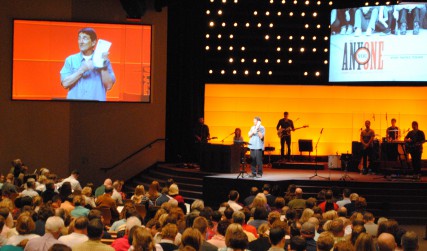
Despite the tough economy, many of the nation’s largest churches are thriving, with increased offerings and plans to hire more staff, a new survey shows.
Just 3 percent of churches with 2,000 or more attendance surveyed by Leadership Network, a Dallas-based church think tank, said they were affected “very negatively” by the economy in recent years. Close to half – 47 percent – said they were affected “somewhat negatively,” but one-third said they were not affected at all.
The vast majority – 83 percent – of large churches expected to meet their budgets in 2012 or their current fiscal year. A majority of large churches also reported that offerings during worship services were higher last year than in 2011.
Even though some churches have ministries that provide other income, such as schools or wedding chapel rentals, an average of 96 percent of their budget comes from members’ donations.
All of the large churches reported that they receive some of their donations electronically, including online, via bank transfer or through a lobby kiosk. One in five of them receive between 31 and 60 percent of their offerings electronically.
Most megachurches surveyed spend 10 percent or more of their budget beyond their congregation on causes ranging from local soup kitchens to world missions.
Another sign of economic well-being: Most large churches report that they expect to give staff at least a 1 percent raise in the next budget cycle. Most also expect to modestly increase staff, and hardly any – just 6 percent – expect to reduce the number of staffers.
The survey of 729 church leaders was released Tuesday (Feb. 19).







I find this article misleading by omission. We know that church attendance and belief in any one particular religion has been declining for years, and that declining rate of growth shows no sign of slowing down. We also know that “conservative” (i.e. Southern Baptist, evangelical, non-denominational) churches are declining at a somewhat faster pace than mainline churches (none of which are growing denominationally). It seems like no leap of logic to assume that evangelical Christians are simply abandoning a smaller church for a larger one. (I’m really curious to get in-depth as to why people are leaving smaller churches for mega churches.)
So, sure, they are meeting budgets now, but as the migration levels off, what then? They don’t seem by anyone’s research to be making new converts. In fact, many people are deciding to just leave faith all-together (the growing cohort of “nones”).
I did some googling and found an article that rounds up the researching I’ve been reading for a number of years: http://www.churchleaders.com/pastors/pastor-articles/139575-7-startling-facts-an-up-close-look-at-church-attendance-in-america.html?p=1